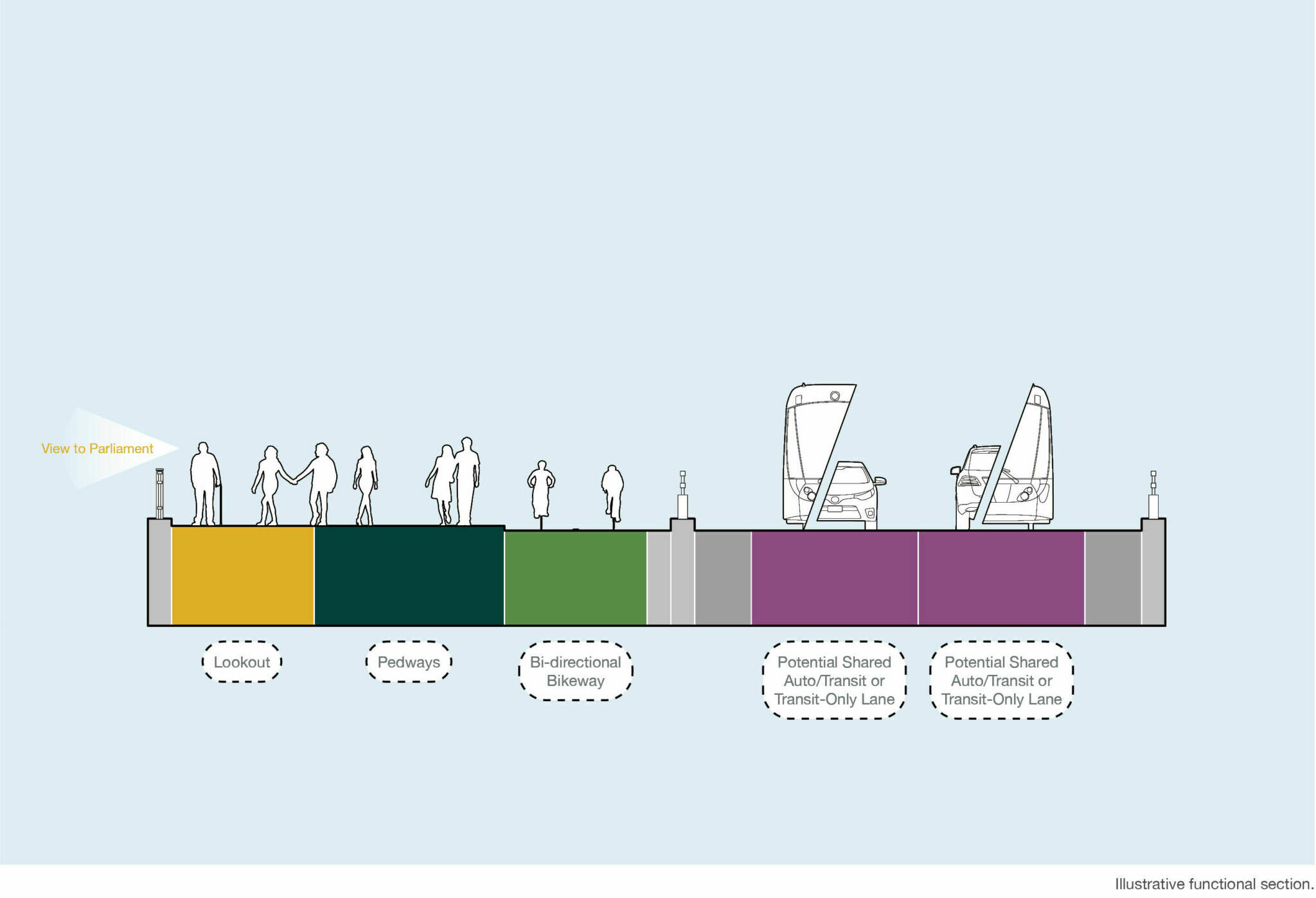Alexandra Bridge Replacement
The Alexandra Bridge has been an iconic feature of the Ottawa–Gatineau skyline for over 120 years. Originally built to accommodate rail and other modes of transportation, the bridge is now used annually by thousands of pedestrians, cyclists and motorists. It is reaching the end of its service life, and is due for replacement. Ongoing repairs will allow it to remain in use until the planned start of construction in 2028.In partnership with Public Services and Procurement Canada (PSPC) — the department responsible for the management of the Alexandra Bridge — the NCC is leading a comprehensive engagement process on this project.
The latest on the project
The Alexandra Bridge replacement project is in the planning stage.
Impact assessment
On March 23, 2023, the Impact Assessment Agency of Canada determined that an impact assessment is not required for this project.
Notice of Impact Assessment Decision with Reasons
Request for proposals for technical advisor
On October 7, 2022, PSPC issued a request for proposals (RFP) to retain services to assist with the design and construction of the new bridge. This work includes the development of conceptual design options, which will be subject to public consultations in fall 2023.
Performance criteria for bridge design
The NCC has developed criteria against which it will evaluate the conceptual designs of the bridge. These criteria are based on the planning and design principles that were the subject of a public consultation in the fall of 2020.
Performance criteria
About the Alexandra Bridge
The Alexandra Bridge was the second of five interprovincial bridges linking the cities of Ottawa, Ontario, and Gatineau, Quebec. The bridge spans the Ottawa River from Kìwekì Point (formerly Nepean Point) in Ottawa to the Canadian Museum of History in Gatineau. On an average daily basis, the bridge is used in approximately 9 percent of interprovincial crossings by motorists and about 33 percent of crossings by active mobility users (e.g. pedestrians, cyclists, users of mobility devices).
The bridge is a major national landmark. It is recognized for its iconic beauty and world-class workmanship. Here’s a brief overview of its history.
- 1898–1900: Construction of the Alexandra Bridge, the first cantilevered span bridge in Canada, by Canadian engineers and designers.
- 1901: The bridge is completed.
- 1995: The bridge is designated a National Historic Civil Engineering Site by the Canadian Society for Civil Engineering.
- 2010: A heritage value assessment rates the bridge as an engineering asset of national historic importance.
- 2017: The bridge is included on the City of Ottawa’s Heritage Register for its cultural heritage value or interest.
- 2018: A life cycle cost analysis determines that replacing the bridge would be less disruptive to the public than trying to maintain the existing bridge, and would also be more cost-effective.
- 2019: The Government of Canada directs that the bridge be replaced within 10 years.
- 2019: Pre-planning for a replacement bridge begins.
- 2021: The bridge is added to the National Trust for Canada’s Endangered Places List.
Basic requirements of the new bridge
The new bridge will be designed in a way that allows simultaneous use for active mobility, public transportation and personal vehicles.
The following requirements reflect some of the input received in the first round of consultation.
- Two lanes for vehicle traffic (one in each direction) that can be easily adapted for a tram or light rail system.
- One lane for two-way active mobility (pedestrians, cyclists and users of mobility devices), wider than today's, with clear separation of pedestrians and cyclists, on the west side of the bridge. It should include seating to provide safe and unobstructed rest points and viewing locations.
- All lanes will have a solid surface to protect the bridge from the elements, de-icing products and dirt. This will allow for a longer-lasting structure.

Planning and design principles
The vision for the new structure is to create a bridge as a unique civic place, reflective of Canadian values and identity, and respectful of the integrity of the national capital’s cultural landscapes.
The following guiding principles will provide additional direction on the design of the new bridge in the areas of planning, heritage protection, urban design and sustainability.
During the first round of consultation in fall 2020, over 3,000 participants gave feedback on these principles. In June 2021, the NCC Board of Directors approved them.

Mobility and continuity of the urban fabric
- The new bridge will continue to complement the Confederation Boulevard ceremonial route, and seamlessly connect pedestrians, cyclists and drivers between Ottawa and Gatineau.

Public space and civic experiences
- The new bridge will be a strong and dynamic public space that will create new opportunities for enhancing the communal, cultural and sensory experiences.

Structure, height, proportions and lighting
- The new bridge will be designed as a signature bridge that will complement the landscape and landmarks of the Capital. It will build on and continue the legacy of our national icons.

Preservation of views and celebration of the bridge’s legacy
- The new bridge will maintain the essence of the Alexandra Bridge, while continuing to allow visitors to view and experience the Ottawa River and the Capital’s cultural landscape.

Sustainability and materiality
- The new bridge will be a model of sustainability and respect traditional Indigenous knowledge as part of its core values and conceptualization.

Universal accessibility, legibility and wayfinding
- The new bridge will provide equitable and safe access for all users. It will provide clear and consistent wayfinding throughout the Confederation Boulevard route for daily commuters and visitors alike.
Alexandra Bridge planning and design principles
What the project means for you
The replacement of the Alexandra Bridge is a unique opportunity to reimagine this vital connection between Ottawa and Gatineau. We are analyzing the many impacts that this project could have, and are looking for solutions.
Traffic
Careful consideration will be given to the impact that the construction activities will have on vehicle and active traffic, traffic management operations, public and private transit operators, emergency services, and businesses in the vicinity of the bridge.
Environment and sustainability
The replacement of the bridge will be planned to optimize health and safety, environmental protection, and the principles of sustainable development, including resilience, low carbon emissions and waste reduction.
The project team will conduct further studies to understand the potential impacts of the project, for example, on fisheries, archaeology and wildlife.
Life, work and recreation
The replacement of the bridge will be planned to limit the effects of construction (e.g. noise, vibration, dust and so on) and other disruptions to nearby communities, landowners and businesses, as well as visitors to the region.
There may be temporary impacts on access to neighbouring green spaces and the Ottawa River.
- Neighbouring boat launch, wharf and marina: We recognize the importance of recreational and commercial boating in the area, and will continue to engage with the public, stakeholders and Indigenous partners on this matter.

Alexandra Bridge Replacement
Every day, we work to build an inspiring capital that is a source of pride for all Canadians.





:quality(100)/cloudfront-us-east-1.images.arcpublishing.com/lescoopsdelinformation/6DKU3OIOIBDYPOVKKPY3ETB2JA.jpg)
:quality(100)/cloudfront-us-east-1.images.arcpublishing.com/lescoopsdelinformation/YNF6QQ4LMJFP5EBKSJ5LO54XAE.jpg)
:quality(100)/cloudfront-us-east-1.images.arcpublishing.com/lescoopsdelinformation/ULXFUGCH6RBJZFMHSHOOW4AUIU.jpg)
:format(url)/cloudfront-us-east-1.images.arcpublishing.com/lescoopsdelinformation/6DKU3OIOIBDYPOVKKPY3ETB2JA.jpg)
